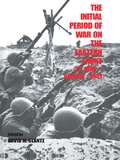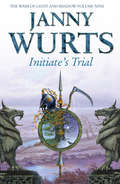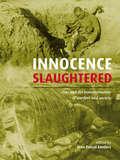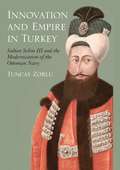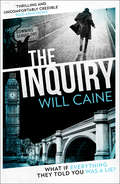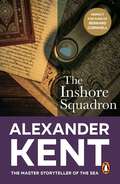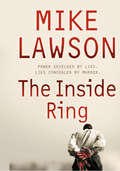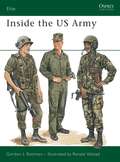- Table View
- List View
Inheriting the Bomb: The Collapse of the USSR and the Nuclear Disarmament of Ukraine (Johns Hopkins Nuclear History and Contemporary Affairs)
by Mariana BudjerynThe collapse of the Soviet Union unleashed the specter of the largest wave of nuclear proliferation in history. Why did Ukraine ultimately choose the path of nuclear disarmament?The collapse of the Soviet Union in 1991 left its nearly 30,000 nuclear weapons spread over the territories of four newly sovereign states: Belarus, Kazakhstan, the Russian Federation, and Ukraine. This collapse cast a shadow of profound ambiguity over the fate of the world's largest arsenal of the deadliest weapons ever created. In Inheriting the Bomb, Mariana Budjeryn reexamines the history of nuclear predicament caused by the Soviet collapse and the subsequent nuclear disarmament of the non-Russian Soviet successor states.Although Belarus and Kazakhstan renounced their claim to Soviet nuclear weapons, Ukraine proved to be a difficult case: with its demand for recognition as a lawful successor state of the USSR, a nuclear superpower, the country became a major proliferation concern. And yet by 1994, Ukraine had acceded to the Treaty on the Non-proliferation of Nuclear Weapons (NPT) as a non-nuclear-weapon state and proceeded to transfer its nuclear warheads to Russia, which emerged as the sole nuclear successor of the USSR. How was this international proliferation crisis averted? Drawing on extensive archival research in the former Soviet Union and the United States, Budjeryn uncovers a fuller and more nuanced narrative of post-Soviet denuclearization. She reconstructs Ukraine's path to nuclear disarmament to understand how its leaders made sense of the nuclear armaments their country inherited. Among the various factors that contributed to Ukraine's nuclear renunciation, including diplomatic pressure from the United States and Russia and domestic economic woes, the NPT stands out as a salient force that provided an international framework for managing the Soviet nuclear collapse.
Inheriting the Bomb: The Collapse of the USSR and the Nuclear Disarmament of Ukraine (Johns Hopkins Nuclear History and Contemporary Affairs)
by Mariana BudjerynThe collapse of the Soviet Union unleashed the specter of the largest wave of nuclear proliferation in history. Why did Ukraine ultimately choose the path of nuclear disarmament?The collapse of the Soviet Union in 1991 left its nearly 30,000 nuclear weapons spread over the territories of four newly sovereign states: Belarus, Kazakhstan, the Russian Federation, and Ukraine. This collapse cast a shadow of profound ambiguity over the fate of the world's largest arsenal of the deadliest weapons ever created. In Inheriting the Bomb, Mariana Budjeryn reexamines the history of nuclear predicament caused by the Soviet collapse and the subsequent nuclear disarmament of the non-Russian Soviet successor states.Although Belarus and Kazakhstan renounced their claim to Soviet nuclear weapons, Ukraine proved to be a difficult case: with its demand for recognition as a lawful successor state of the USSR, a nuclear superpower, the country became a major proliferation concern. And yet by 1994, Ukraine had acceded to the Treaty on the Non-proliferation of Nuclear Weapons (NPT) as a non-nuclear-weapon state and proceeded to transfer its nuclear warheads to Russia, which emerged as the sole nuclear successor of the USSR. How was this international proliferation crisis averted? Drawing on extensive archival research in the former Soviet Union and the United States, Budjeryn uncovers a fuller and more nuanced narrative of post-Soviet denuclearization. She reconstructs Ukraine's path to nuclear disarmament to understand how its leaders made sense of the nuclear armaments their country inherited. Among the various factors that contributed to Ukraine's nuclear renunciation, including diplomatic pressure from the United States and Russia and domestic economic woes, the NPT stands out as a salient force that provided an international framework for managing the Soviet nuclear collapse.
The Initial Period of War on the Eastern Front, 22 June - August 1941: Proceedings Fo the Fourth Art of War Symposium, Garmisch, October, 1987 (Soviet (Russian) Military Experience)
by David M. GlantzBeginning with Operation Barbarossa, the German invasion of the Soviet Union in June 1941, this volume draws upon eye-witness German accounts supplemented with German archival and detailed Soviet materials. Formerly classified Soviet archival materials has been incorporated.
The Initial Period of War on the Eastern Front, 22 June - August 1941: Proceedings Fo the Fourth Art of War Symposium, Garmisch, October, 1987 (Soviet (Russian) Military Experience)
by David M. GlantzBeginning with Operation Barbarossa, the German invasion of the Soviet Union in June 1941, this volume draws upon eye-witness German accounts supplemented with German archival and detailed Soviet materials. Formerly classified Soviet archival materials has been incorporated.
Initiate’s Trial: First book of Sword of the Canon (The Wars of Light and Shadow #9)
by Janny WurtsThe long-awaited beginning of the fourth story arc - Sword of the Canon - in the epic fantasy series, the Wars of Light and Shadow.
Innocence
by Penelope FitzgeraldStunning modern new cover reissue of one of Penelope Fitzgerald’s best-loved novels
Innocence: two novellas
by Frank WhiteIn 2017 Hodder published Frank White's There Was A Time, surely the last novel about the Second World War to be written by someone who actually served in it. Now at the age of 93, Frank has written a poignant, nostalgic novella of coming of age in a Yorkshire village in the sixties and it is paired with another short novel set in Manchester at the outbreak of war and first published by Hodder in 1964. Innocence and A Morse Code Set are beautifully complementary in theme and show Frank White to be an author of extraordinary insight and tenderness.
Innocence Slaughtered: Gas and the Transformation of Warfare and Society
by Jean Pascal ZandersThis collaborative work investigates the unfolding catastrophe that the unleashing of chlorine against the Allied positions meant for individual soldiers and civilians. It describes the hesitation on the German side about the effectiveness, and hence impact on combat operations of the weapon whilst reflecting on the lack of Allied response to the many intelligence pointers that something significant was afoot.It goes on to describe the massive transformation that societies were undergoing as a consequence of industrialisation, science and technology, and the impact these trends were to have on the emergence of what we know today as 'total war'. Chemical warfare pitted the brightest minds from the various belligerents against each other and in some ways this competition revealed early thinking about intellectual superiority that was to define the decades after the Armistice. The ability to survive in a chemically contaminated environment was proof of a higher level of achievement. In simple terms, chemical defence equalled survival of the fittest.
Innocents Lost: When Child Soldiers Go To War
by Jimmie BriggsIda, a member of Sri Lanka's Female Tamil Tigers, fought with one of the longest-surviving and successful guerilla movements in the world. She is sixteen. Francois, a fourteen-year-old Rwandan child of mixed ethnicity, was forced by Hutu militiamen to hack to death his sister's Tutsi children.More than 250,000 children have fought in three dozen conflicts around the world, but growing exploitation of children in war is staggering and little known. From the “little bees” of Colombia to the “baby brigades” of Sri Lanka, the subject of child soldiers is changing the face of terrorism. For the last seven years, Jimmie Briggs has been talking to, writing about, and researching the plight of these young combatants. The horrific stories of these children, dramatically told in their own voices, reveal the devastating consequences of this global tragedy.Cogent, passionate, impeccably researched, and compellingly told, Innocents Lost is the fullest, most personal and powerful examination yet of the lives of child soldiers.
Innovation and Empire in Turkey: Sultan Selim III and the Modernisation of the Ottoman Navy
by Tuncay ZorluOttoman naval technology underwent a transformation under the rule of Sultan Selim III. New types of sailing warships such as two- and three-decked galleons, frigates and corvettes began to dominate the Ottoman fleet, rendering the galley-type oared ships obsolete. This period saw technological innovations such as the adoption of the systematic copper sheathing of the hulls and bottoms of Ottoman warships from 1792-93 onwards and the construction of the first dry dock in the Golden Horn.The changing face of the Ottoman Navy was facilitated by the influence of the British, Swedish and French in modernising both the shipbuilding sector and the conduct of naval warfare. Through such measures as training Ottoman shipbuilders, heavy reliance on help from foreign powers gave way to a new trajectory of modernization. Using this evidence Zorlu argues that although the Ottoman Empire was a major and modern independent power in this period, some technological dependence on Europe remained.
Innovation and Empire in Turkey: Sultan Selim III and the Modernisation of the Ottoman Navy (Library Of Ottoman Studies)
by Tuncay ZorluOttoman naval technology underwent a transformation under the rule of Sultan Selim III. New types of sailing warships such as two- and three-decked galleons, frigates and corvettes began to dominate the Ottoman fleet, rendering the galley-type oared ships obsolete. This period saw technological innovations such as the adoption of the systematic copper sheathing of the hulls and bottoms of Ottoman warships from 1792-93 onwards and the construction of the first dry dock in the Golden Horn. The changing face of the Ottoman Navy was facilitated by the influence of the British, Swedish and French in modernising both the shipbuilding sector and the conduct of naval warfare. Through such measures as training Ottoman shipbuilders, heavy reliance on help from foreign powers gave way to a new trajectory of modernization. Using this evidence Zorlu argues that although the Ottoman Empire was a major and modern independent power in this period, some technological dependence on Europe remained.'A valuable and well researched study… Zorlu ably surveys and analyses the developments which took place in Ottoman shipbuilding technology in the late eighteenth and early nineteenth centuries.' - Colin Heywood, University of Hull
Innovation in Bayern: Die Rezeption und Adaption technischer Innovationen in der bayerischen Armee (1835-1866)
by Dirk KränzleinDieses Open-Access-Buch befasst sich mit der Einstellung der bayerischen Militärführung in Hinblick auf die Rezeption als auch Adaption technischer Innovation bzw. deren ersten praktischen Anwendung im Krieg von 1866.Das 19. Jahrhundert stellte das bayerische Königreich vor mehrere Herausforderungen. Die militärische Partizipation an den Napoleonischen Kriegen endete zwar erfolgreich, jedoch brachte sie beinahe die Zahlungsunfähigkeit des Staates mit sich. Obwohl die bayerische Streitmacht nach wie vor den großen Stolz des Landes darstellte, rückte sie fortan in den Fokus der Einsparungspolitik König Ludwigs I. Folglich waren die Mittel, welche der Armee zur Verfügung gestellt wurden, streng reguliert und reichten lediglich dafür aus, um die laufenden Kosten zu decken. Eine schleichende, degenerative Heeresentwicklung – sowohl auf personeller, als auch technischer Ebene – resultierte hieraus.Problematisch wurde diese Vernachlässigung, nachdem immer mehr europäische Streitmächte einen technischen Modernisierungsprozess begannen. Neue Waffensysteme wurden erprobt und eingeführt, die Nutzung der Eisenbahn zur Erhöhung der Mobilität diskutiert.Wie stand die bayerische Armeeführung diesen Entwicklungen gegenüber? Konnten bzw. durften derartige Prozesse einfach ignoriert werden?
The Inquiry
by Will CaineKnowledge of these files is classified. You must not use police or intelligence services to carry out your investigation. Those channels are compromised. A final warning: you must move fast.
The Inquisitor
by Gayle WilsonThe serial murderer dubbed the Inquisitor has already killed over a dozen women in various cities, and the authorities haven't a clue to his identity. He is organized, methodical and certain to kill again. And now he's set his sights on Birmingham psychologist Jenna Kincaid.
The Inshore Squadron: Naval Fiction (Richard Bolitho: Book 15) (Richard Bolitho #Bk. 13)
by Alexander KentThe Inshore Squadron is the twelfth Richard Bolitho story and chronologically it follows the events covered by Signal - Close Action!In September 1800 Richard Bolitho, a freshly appointed rear-admiral, assumes command of his own squadron - but, as the cruel demands of war spread from Europe to the Baltic, he soon realizes that his experience, gained in the line of battle, has ill-prepared him for the intricate manoeuvring of power politics.Under his flag the Inshore Squadron has to ride out the bitter hardship of blockade duty and the swift, deadly encounters with the enemy. An old hatred steps from the past to pose a personal threat to him, but at the gates of Copenhagen, where his flag flies admidst the fury of battle, Bolitho must put all private hopes and fears behind him.
Inside The Centre: The Life of J. Robert Oppenheimer
by Ray MonkJ. Robert Oppenheimer is among the most contentious and important figures of the twentieth century. As head of the Los Alamos Laboratory, he oversaw the successful effort to beat the Nazis to develop the first atomic bomb – a breakthrough which was to have eternal ramifications for mankind, and made Oppenheimer the 'father of the Bomb'.But his was not a simple story of assimilation, scientific success and world fame. A complicated and fragile personality, the implications of the discoveries at Los Alamos were to weigh heavily upon him. Having formed suspicious connections in the 1930s, in the wake of the Allied victory in World War Two, Oppenheimer’s attempts to resist the escalation of the Cold War arms race would lead many to question his loyalties – and set him on a collision course with Senator Joseph McCarthy and his witch hunters.
Inside The Danger Zones: Travels To Arresting Places
by Paul MoorcraftSometimes hilarious, sometimes tragic, Inside the Danger Zones is the story of Paul Moorcraft's work during the major wars of the last three decades. As a freelance war correspondent and military analyst for many of the top TV networks, Moorcraft has parachuted into countless war zones and has worked in Angola, Namibia, South Africa, Zimbabwe and Mozambique. He has the habit of being in the wrong place at the worst of times, from the siege of Sarajevo in the 1990s to the siege of the West Bank town of Jenin in 2002. This book takes him to a series of conflicts from Afghanistan to Zimbabwe, covering coups and counter-coups across the globe. Along the way he encounters some of the most dangerous people in the world; in Afghanistan when the West was training bin Laden's Mujahedin fighters, interviewing Mugabe during the Rhodesian Bush War of the late 1970s and travelling to meet Saddam on the eve of the 2003 allied invasion if Iraq. Paul Moorcraft has been a freelance war correspondent for, among others, Time magazine, the BBC, Channel 4, Sky and Al-Jazeera. He was a senior instructor at the Royal Military Academy, Sandhurst, and the UK Joint Services Command and Staff College. Moorcraft is currently the director of the Centre for Foreign Policy Analysis, London, and a visiting professor at Cardiff University's School of Journalism, Media and Cultural Studies.
Inside Pepys' London
by Jonathan BastableInside Pepys' London reveals a vivid picture of London at a critical point in history - poised to become a major centre of international commerce and culture. It provides accounts of all aspects of contemporary life, from the arts and entertainment, to politics and religion. Though no king or great general, thanks to his diary Samuel Pepys is one of the most interesting characters in history. His life encompassed happenings of huge historical and human impact - the execution of Charles I and the Great Fire of London to name but two. This book takes Pepys' diary, which he kept almost daily from 1660-1669, as its central resource, but also includes a range of other contemporary sources to provide a fascinating and vivid picture of the times.
The Inside Ring: A Joe Demarco Thriller (The\joe Demarco Thrillers Ser. #1)
by Mike LawsonThe West Wing meets 24 in a pace-ridden thriller of conspiracy, corruption and cold-blooded murder.
Inside SEAL Team Six: My Life and Missions with America's Elite Warriors
by Don MannThe Inside Story of America's Ultimate Warriors When Osama bin Laden was assassinated, the entire world was fascinated by the men who had completed the seemingly impossible mission that had dogged the U.S. government for over a decade. SEAL Team 6 became synonymous with heroism, duty, and justice. Only a handful of the elite men who make up the SEALs, the US Navy's best and bravest, survive the legendary and grueling selection process that leads to becoming a member of Team 6, a group so classified it technically does not even exist. There are no better warriors on Earth. Don Mann knows what it takes to be a brother in this ultra-selective fraternity. As a member of Seal Team Six for over eight years and a SEAL for over seventeen years, he worked in countless covert operations, operating from land, sea, and air, and facing shootings, decapitations, and stabbings. He was captured by the enemy and lived to tell the tale, and he participated in highly classified missions all over the globe, including Somalia, Panama, El Salvador, Colombia, Afghanistan, and Iraq. As a coordinator for several civilian SEAL training programs, and as a former Training Officer of SEAL Team Six, he was directly responsible for shaping the bodies and minds of SEALs who carried out the assassination of Osama bin Laden. But to become a SEAL, Mann had to overcome his own troubled childhood and push his body to its breaking point -- and beyond. Inside Seal Team 6 is a high octane narrative of physical and mental toughness, giving unprecedented insight to the inner workings of the training and secret missions of the world's most respected and feared combat unit.
Inside Terrorist Organizations
by David C. RapoportThese original essays describe the internal life of terrorist organizations in fascinating detail. They show how no description of terrorist behaviour is adequate without a grasp of the deep tensions that often characterize such groups, and an appreciation of how firmly implanted in our culture terrorist traditions have become, since the middle of the nineteenth century.
Inside Terrorist Organizations
by David C. RapoportThese original essays describe the internal life of terrorist organizations in fascinating detail. They show how no description of terrorist behaviour is adequate without a grasp of the deep tensions that often characterize such groups, and an appreciation of how firmly implanted in our culture terrorist traditions have become, since the middle of the nineteenth century.
Inside the Jihad: My Life with Al Qaeda
by Omar NasiriFrom Europe's burgeoning terrorist underground, to the training camps of Afghanistan, to the radical mosques of London, this is a unique and chilling insider's story of the rise of Al Qaeda and the intelligence services that struggle to contain it.Between 1994 and 2000, Omar Nasiri worked as a secret agent for Europe's top foreign intelligence services -- including France's DGSE (Direction Générale de la Sécurité Extérieure), and Britain's MI5 and MI6. From the netherworld of Islamist cells in Belgium, to the training camps of Afghanistan, to the radical mosques of London, he risked his life to defeat the emerging global network that the West would come to know as Al Qaeda. Now, for the first time, Nasiri shares the story of his life -- a life balanced precariously between the world of Islamic jihadists and the spies who pursue them. As an Arab and a Muslim, he was able to infiltrate the rigidly controlled Afghan training camps, where he encountered men who would later be known as the most-wanted terrorists on earth, going so far as to form a sleeper cell in Europe with Al Qaeda's top recruiter in Pakistan and London's radical cleric Abu Qatada.A detailed portrait of a complex man who fought on both sides, Inside the Jihad is a terrifying, suspenseful look at an organization that continues to be a global threat.
Inside the US Army (Elite)
by Gordon L. Rottman Ronald VolstadWhen conscription was eliminated in the early 1970s, the US Army found itself with a very different kind of soldier. While the personality of the Army remained the same, the organization of its higher levels of command and combat formations, and the internal structure of its units underwent major changes under the 'Army of Excellence' program of the 1980s. This book explores the US Army of the late 80s, including the training methods, weapon systems, Reserve Components, organization and uniforms of one of the world's most potent fighting forces. The text is illustrated with numerous photographs and eight colour plates.
Inside the US Army (Elite #20)
by Gordon L. Rottman Ronald VolstadWhen conscription was eliminated in the early 1970s, the US Army found itself with a very different kind of soldier. While the personality of the Army remained the same, the organization of its higher levels of command and combat formations, and the internal structure of its units underwent major changes under the 'Army of Excellence' program of the 1980s. This book explores the US Army of the late 80s, including the training methods, weapon systems, Reserve Components, organization and uniforms of one of the world's most potent fighting forces. The text is illustrated with numerous photographs and eight colour plates.

